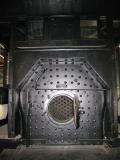
| Home | Open Account | Help | 251 users online |
|
Member Login
Discussion
Media SharingHostingLibrarySite Info |
Steam & Excursion > Never say "Never"?Date: 03/30/15 15:15 Never say "Never"? Author: LarryDoyle Were any camelback locomotives ever outfitted with a stoker?
-John Date: 03/30/15 15:24 Re: Never say "Never"? Author: HotWater Interesting question, John. Who would operate the stoker, if one had been installed, and where would the "operator" be seated?
Date: 03/30/15 16:56 Re: Never say "Never"? Author: callum_out I would presume the fireman, but the biggest camelbacks were built before the stoker was introduced. Camelback
fireman duty had to be right up there with the narrow gauge brakemen riding the tops during a snow storm. Out Date: 03/30/15 17:41 Re: Never say "Never"? Author: PHall Some of the camelbacks had fireboxes so big they had two firedoors and required two firemen.
Date: 03/30/15 17:51 Re: Never say "Never"? Author: LarryDoyle callum_out Wrote:
------------------------------------------------------- > ... but the biggest > camelbacks were built before the stoker was > introduced. Huge bituminous/lignite engines were built before the stoker was introduced, as well. Many with two firedoors, stoked by two firemen - later retrofitted with stokers. My question is whether any anthracite engines were so retrofitted. Of course, anthracite generally has a higher BTU/lb ratio than other coals, so less intense shoveling would be required. > Camelback fireman duty had to be right up there with the > narrow gauge brakemen riding the tops during a > snow storm. I've addressed this issue before, here on TO. I believe it's a myth that camelback firemen were mistreated when compared to bituminous/lignite firemen. First, they had to do less shoveling/BTU, and second their "accommodations" were actually identical to those of other firemen of the period! Look at locomotive design in the 1870 to 1905 period. The first drawing below which shows a typical camelback arrangement for crew protection: The cab is moved ahead of the firebox so the engineer can sit beside the boiler, since the firebox is too wide to permit moving it farther back, and there is a false wall near the backhead with a roof awning overhead for the firemans' comfort. The fireman stood on the front deck of the tender behind this wall and the backhead. Compare that to the conventional "deckless cab" designs for bituminous engines, shown in the second drawing. The cab sits astride the firebox with the engineer sitting next to the firebox. The rear cab wall is roughly even with the backhead, and the fireman is located behind the rear cab wall, under the roof awning, on the front deck of the tender - exactly the same as if on a camelback. -John   Date: 03/30/15 19:24 Re: Never say "Never"? Author: Mgoldman Interesting topic - while we're discussing cabs, why were the boilers extended
into the cab in such designs? Considering that is not the case in many locomotives and that the frame most likely could've been extended to provide some added room as is the case in more modern - and perhaps even then current designs of the time? /Mitch Date: 03/30/15 20:22 Re: Never say "Never"? Author: Realist Mgoldman Wrote:
------------------------------------------------------- > Interesting topic - while we're discussing cabs, > why were the boilers extended > into the cab in such designs? Considering that > is not the case in many locomotives > and that the frame most likely could've been > extended to provide some added > room as is the case in more modern - and perhaps > even then current designs of > the time? > > /Mitch That put the firebox door much closer to the coal pile. Camelbacks with 2 firedoors seldom had 2 fireman. These were engines with very wide fireboxes. Two doors allowed the fireman to keep both back corners filled. Date: 03/31/15 07:18 Re: Never say "Never"? Author: LarryDoyle The cab could be fully enclosed. Sure, you could extend the tail of the frame and leave the back of the cab open, as was done on later engines when fireboxes became wider (and, as you note, on some narrow firebox engines of the period), but an equally valid question would be, " why make the boiler and firebox smaller?"
Here's a firemans' eye view of a deckless cab. Klondike Mines #3. -John Mgoldman Wrote: ------------------------------------------------------- > Interesting topic - while we're discussing cabs, > why were the boilers extended > into the cab in such designs? Considering that > is not the case in many locomotives > and that the frame most likely could've been > extended to provide some added > room as is the case in more modern - and perhaps > even then current designs of > the time? > > /Mitch   |